The Second World War
During the Second World War the 4th Hussars were seemingly destroyed, time after time, only to rise phoenix-like from the ashes to find their next enemy.
From 1941 they were under the watchful eye of their Colonel of the Regiment, Winston Churchill who certainly helped to guide their fate. They initially fought in Greece but withdrew in the face of a numerically superior German force sent to pacify the region.
Greece 1941
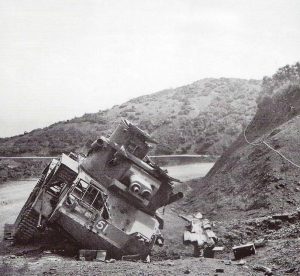
4th Hussars. Greece 1941
Germany invaded Yugoslavia and Greece on 6 April 1941 in support of their failing allies the Italians. Outnumbered on the ground and in the air the Greek and Allied forces were unable to deploy sufficient troops in any one area to halt the German advance.
The 4th Hussars arrived in Greece on 10-11 March 1941 having sailed from Alexandria on the 9th.
The campaign in Greece was hindered by poor communications between the Greek and Allied commanders, the difficult terrain and the under-developed road and rail system.
They executed a magnificent holding action at Proasteion on 13 April that allowed the infantry to withdraw, the Germans under the impression that they were faced by a whole armoured division.
They were often the rearguard as the retreat continued all the way down Greece and onto the Peleponnese where they were detailed to defend the whole north shore against landings while the allied troops were evacuated further south.
On the 26th the Corinth Canal Bridge, held by three tanks and four platoons of men from RHQ, was attacked by over 1,000 gliders and paratroopers who eventually overran the British but not before the bridge was blown up successfully.
Only 12 officers and 160 other ranks made it out of Greece and nearly all of these were from the rear echelons, all the vehicles being disabled and abandoned.
Why not read the story of LCpl Patrick Fury, who was captured in Greece, along with most of the Regiment.
In June 1941 the Regiment began to reconstitute in Cario.
By April 1942 they were issued with Grant and Stuart tanks and then joined the 1st Armoured Brigade.
Retreat from Gazala to Alamein Line, 26 May-27 Jul 1942
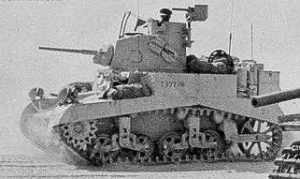
Stuart Light Tank
The 4th Queen’s Own Hussars and the 8th King’s Royal Irish Hussars both fought in this disastrous battle that marked the beginning of Rommel’s great advance across North Africa.
The 8th was in the 4th Armoured Brigade, part of the 7th Armoured Division, which was at Bir Hacheim, the southern end of the defensive line stretching up to Gazala on the coast.
On 26 May the 8th was faced with a large force of heavy enemy tanks that left ‘A’ and ‘B’ Squadrons with only three tanks between them.
However, the regiment had destroyed a third of the German tanks before they were overwhelmed: even Divisional HQ was overrun.
‘C’ Squadron was attached to 3 RTR and was involved in heavy fighting around Bir el Harmat for many days. The 4th arrived with the 1st Armoured Brigade on 2 June at Capuzzo and apart from B Squadron immediately lost all of its tanks to other units. ‘B’ Squadron lost all but one tank in an ambush on 12 June.
The whole of the 8th Army began its long and hard fighting retreat to prepare defences at the Alamein Line. The composite Squadron of the 8th was involved in the breakout of the pocket at Mersa Matruh.
The 4th Hussars were heavily involved in the defence of the Alamein Line throughout July, with especially hard fighting defending the Ruweisat Ridge 2-6 July. They were joined late in the month by ‘C’ Squadron, 8th Hussars, to form the 4/8th Hussars.
Alam El Halfa, 30 August – 7 September 1942
For the battle of Alam el Halfa, the regiment joined the similarly wounded 8th becoming The 4th/8th Hussars, equipped with Stuart tanks.
At the end of August, they were told to move from the Qattara Depression to the top of the escarpment to ambush Rommel’s columns and on finding a supply column they dealt with 57 lorries.
For the battle of El Alamein, the 4th/8th operated in the Southern flank in the 4th Light Armoured Brigade doing diversionary attacks before taking the lead in pursuing the Africa Korps back to Tunis, and capturing the strategically important Halfaya Pass. In November the 4th/8th split up, with the 4th moving to Cyprus for a rest and then further training.
In June 1943 they moved back to Egypt for a year’s training.
The Gothic Line, 3-21 September 1944
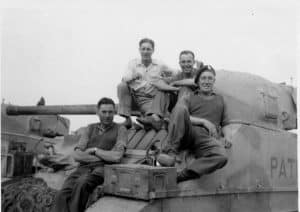
4th Hussars, Italy, 1944
In April 1944 the 4th Hussars rejoined the fray in Italy as the Armoured Reconnaissance of the 1st Armoured Division equipped with both heavy and light tanks.
They were consistently in close support of the infantry assaults on the successive enemy positions, suffering heavy casualties from close anti-tank fire.
After ten days they burst through the line and were then able to clear the Divisional axis single-handed at Cerasuolo on 20 September, through the Rimini Line.
They then continued to push up through Italy equipped with ‘Kangaroo’ armoured personnel carriers which they utilized well in clearing a pocket from the east bank of the Senio River which earned them the Army Commander’s Congratulations. Why not discover more about The ‘Kangaroos’, of the 4th Hussar’s operations in Italy.
Senio Pocket, 4-5 January 1945
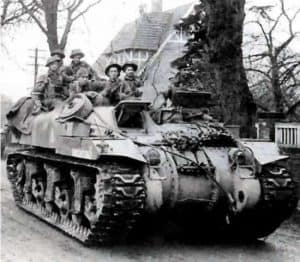
4th Hussars, Kangaroo, Italy 1945
The 4th Hussars were now equipped with the new ‘Kangaroo’ infantry carriers with the Regiment able to transport a Brigade at a time, though keeping one Squadron of tanks.
From 2 January ‘A’ and ‘B’ Squadrons fiercely resisted strong German attacks on the Allied line between Conventello and Lake Comacchio, successfully holding the line.
The 4th of January saw the first proper use of the’ Kangaroos’ by ‘C’ Squadron in the deliberate assault on the “Senio Pocket”, a bulge in the Allied line strongly held by the Germans.
The infantry was carried onto their objectives so rapidly that the enemy was totally overrun before they could recover from their shock, being forced to blow the bridge over the Sento before many of their troops escaped.
There was another lull in the conflict until April 1945 before the final battles up to the River Po and at the Argenta Gap.
Argenta Gap, 9-21 April 1945
The 4th Hussars played a leading role in this, the last violent battle of the war.
They supported the infantry divisions in their shattering assault crossings of the River Senio and the River Santerno, both strongly held by the Germans before the 8th Army came up the Argenta Gap.
Why not read the diary entries of Trooper Ron Goldstein, who was the Operator/Gunner on ‘A’ Squadron’s SSM Stuart Jalopy.
This was a narrow defile created by flooding the fields on either side of the road, which ran along an embankment. The 4th led the charge up this road supported by armour going so fast that they took the Germans by surprise and opened up the way to exploit the rear areas, capturing 500 prisoners, eight tanks and numerous other pieces.
Battle Honours
The 4th Queens Own Hussars were awarded a total of 18 battle honours during this period.
Why not find out the stories behind each one:
- Gazala
- Defence of Alamein Line
- Ruweisat
- Alam El Halfa
- El Alamein
- North Africa 1942
- Proateion
- Corinth Canal
- Greece 1941
- Coriano
- San Clemente
- Rimini Line
- Conventello-Comacchio
- Senio Pocket
- Senio
- Santerno Crossing
- Argenta Gap
- Italy 1944-45
Campaign Medals
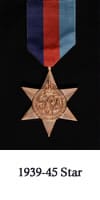
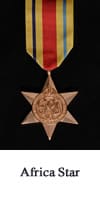
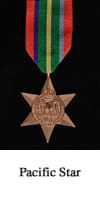
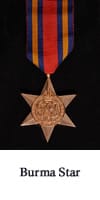
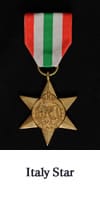
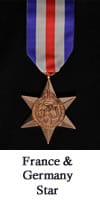

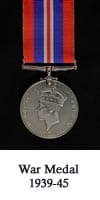
A series of various stars were issued for the campaigns of World War 2. The colours of the ribbons have symbolic significance and are believed to have been designed personally by King George VI.
No more than 5 stars may be awarded to one person. Those who qualify for more are awarded a clasp with the title of one of the stars to which they qualify. The clasp is then attached to the ribbon of one of the other stars.
1939 to 1945 Star. The 1939 to 1945 Star was awarded to personnel who completed operational service overseas between 3 September 1939 and 8 May 1945 (2 Sept 1945 in the Far East).
Africa Star. The Africa Star was awarded to personnel who served in North Africa, Malta or Egypt between 10 June 1940 and 12 May 1943.
Pacific Star: Malaya, Singapore and the Pacific Ocean. The Pacific Star was awarded for operational service in Malaya, Singapore, China, Hong Kong or Sumatra between 8 December 1941 and 2 September 1945.
Burma Star. The Burma Star was awarded for operational service in Burma between 11 December 1941 and 2 September 1945. Those serving in Bengal and Assam in India and China, Hong Kong, Malaya or Sumatra between other specified dates may also qualify.
Italy Star. The Italy Star was awarded for operational service in Sicily or Italy between 11 July 1943 and 8 May 1945. Those who served in Yugoslavia, Greece, Corsica or Sardinia between certain other specified dates would also qualify.
France and Germany Star. The France and Germany Star was awarded for operational service in France, Belgium, Luxembourg, The Netherlands or Germany between 6 June 1944 and 8 May 1945.
The Defence Medal. The Defence Medal is awarded for non-operational services such as those service personnel working in headquarters, on training bases and airfields and members of the Home guard.
War Medal 1939 to 1945. The War Medal was awarded to all full-time personnel of the armed forces wherever they were serving. The medal was granted in addition to campaign stars and the Defence Medal.

